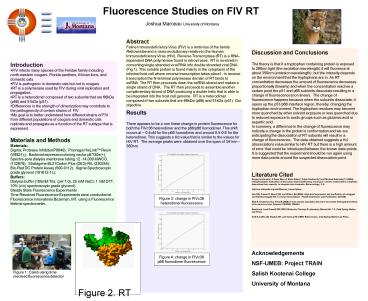Acknowledgements - PowerPoint PPT Presentation
1 / 1
Title: Acknowledgements
1
Fluorescence Studies on FIV RT
Joshua Marceau University of Montana
Abstract Feline Immunodeficiency Virus (FIV) is a
lentivirus of the family Retroviridae and a close
evolutionary relative to the Human
Immunodeficiency Virus (HIV). Reverse
Transcriptase (RT) is a RNA-dependent DNA
polymerase found in retroviruses. RT is involved
in converting single stranded viral RNA into
double stranded viral DNA (Fig 1). This soluble
protein is found mainly in the cytoplasm of the
infected host cell where reverse transcription
takes place1. In reverse transcription the
N-terminal polymerase domain of RT binds to
ssRNA. The RT then proceeds down the ssRNA strand
and makes a single strand of DNA. The RT then
proceeds to assemble another complimentary strand
of DNA producing a double helix that is able to
be integrated into the host cell genome. RT is a
heterodimer composed of two subunits that are
66kDa (p66) and 51kDa (p51). Our objective
Discussion and Conclusions The theory is that if
a tryptophan containing protein is exposed to
280nm light (the excitation wavelength) it will
fluoresce at about 350nm (emission wavelength),
but the intensity depends on the environment that
the tryptophans are in. As RT concentration
decreases the amount of fluorescence decreases
proportionally (linearly) and when the
concentration reaches a certain point the p51 and
p66 subunits dissociate resulting in a change of
fluorescence (non linear). The change of
fluorescence happens because when the subunits
dissociate, it opens up the p51/p66 interface
region, thereby, changing the tryptophan
environment. The tryptophan residues may become
more quenched by ether solvent exposure or less
quenched due to reduced exposure to acidic groups
such as glutamic acid or aspartic acid. In
summery, a difference in the change of
fluorescence may indicate a change in the
proteins conformation and we are anticipating
the dissociation of RT subunits will result in a
change of fluorescence. The data obtained
suggests a Kd (dissociation) value similar to HIV
RT but there is a high amount of error that could
be introduced between the known data points. It
is suggested that the experiment should be run
again using more data points around the suspected
dissociation point.
- Introduction
- FIV infects many species of the Felidae family
including north-western cougars, Florida
panthers, African lions, and domestic cats. - FIV is pathogenic in domestic cats but not in
cougars. - RT is a polymerase used by FIV during viral
replication and propagation. - RT is a heterodimer composed of two subunits that
are 66kDa (p66) and 51kDa (p51). - Differences in the strength of dimerization may
contribute to the pathogenicity of certain
strains of FIV - My goal is to better understand how different
strains of FIV from different populations of
cougars and domestic cats replicate and
propagate as a function of the RT subtype that is
expressed.
Results There appears to be a non linear change
in protein fluorescence for both the FIVc36
heterodimer and the p66/p66 homodimer. This shift
occurs at 0.4uM for the p66 homodimer and
around 0.5-0.6 for the heterodimer. This suggests
a Kd value that is similar to the values for HIV
RT. The average peaks were obtained over the
span of 341nm 360nm
Materials and Methods Materials Sigma, Protease
Inhibitor(P8849) Promega HisLink Resin
(V8821)) Bacterial expression cloning vector
pET30a() Spectra-pore dialysis membrane tubing
12 -14,000 MWCO, (132678) Stratagene BL21Codon
Plus (DE3)-RIL (230245) Bio-Rad DC Protein Assay
(500-0112) Sigma Spectroscopic grade glycerol
(191612-1L) Buffers Dialysis buffer (100mM
Tris, (pH 7.0), 25 mM NaCl, 1 mM DTT, 10 (v/v)
spectroscopic grade glycerol) Steady State
Fluorescence Experiments Time Resolved
Fluorescence Experiments were conducted at
Fluorescence Innovations Bozeman, MT. using a
Fluorescence lifetime spectrometer.
Literature Cited Sergey Iordanskiy,1,2 Reem
Berro,3 Maria Altieri,1 Fatah Kashanchi,3 and
Michael Bukrinsky1,3 (2004) Intracytoplasmic
maturation of the human immunodeficiency virus
type 1 reverse transcription complexes determines
their capacity to integrate into chromatin.
Retrovirology 3 4. http//en.wikipedia.org/wiki
/Reverse_transcriptase Hou EW, Prasad R, Beard
WA, and Wilson SH (2004) High-level expression
and purification of untagged and histidine-tagged
HIV-1 reverse transcriptase. Protein Expression
and Purification 3475-86. Biek R, Drummond AJ,
Poss M (2006) A virus reveals population
structure and recent demographic history of its
carnivore host. Science 311(5760)
538-541. Sambrook J and Russell DW (2001)
Molecular Cloning A Laboratory Manual Vol. 1-3.
Cold Spring Harbor Lab Press. Goff S, Coffin
JM, Hughes SH, and Varmus HE (1997) Retroviruses.
Cold Spring Harbor Lab Press.
Figure 3 change in FIVc36 heterodimer
fluorescence
Another Figure
Acknowledgements NSF-UMEB Project TRAIN Salish
Kootenai College University of Montana
Figure 4 change in FIVc36 p66 homodimer
fluorescence
Figure 1 Caleb using time resolved fluorescence
detector
Figure 2. RT structure. P51 in yellow and p66 in
green































